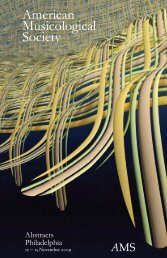Abstracts - American Musicological Society
Abstracts - American Musicological Society
Abstracts - American Musicological Society
Create successful ePaper yourself
Turn your PDF publications into a flip-book with our unique Google optimized e-Paper software.
20<br />
Friday morning<br />
(1605), lJert (1556) and Pallavicino<br />
(1605) ' -and<br />
Palestrina . -72) '"t'i"- Luzzasct-l^ tt::1'<br />
Palestrina (L5 Iz ) aro<br />
i" . tn"ti;;: rhythrnic<br />
.*"rirritrg their meLodic, h."tt:-1<br />
^^*{ ^n<br />
"nd and f ormal<br />
examining the j-l meroqrc' "-'----;stion, and f ormal<br />
)-anguage, i".er"g"] text text,declamaLrotr declarnation and .rre P-toj,: t--'iiff.rentiate ss^-onri at€ tne the<br />
strictires structures and anq proPortions, P!uPvt , --tions . and ,.-A o.rr'l eValuate rrate<br />
contrapuntal styles of these tradl<br />
.-nrrnrl<br />
;:;':;:;";;; .;'iJ;; iv reoo. (rnnova:i:::--:-:"'-:::l:'<br />
'ii6o'^i".t"u" ";;;";;";'<br />
o-f- -or'g""'i'ins<br />
initative points<br />
'<br />
new forms of harmoniL organiiation, Lnd more consistent<br />
synchronizatlon of harnoiic and metric events ' ) I find<br />
tirat the regional traditions for setting<br />
convivium" differed significantly fron one another from<br />
their inception and t'hat these differences persisted<br />
into the seventeenth centurY.<br />
THE NUNC DIMITTIS OF ORLANDO DI LASSO<br />
Peter Bergquist, University of Oregon<br />
Ten settings of the are securelY<br />
ascribed to orlando di Lasso, and two others are almost<br />
certainly his. They survive only in choirbooks copied<br />
for the Bavarian Hofkapelle during Lasso's tenure in<br />
Munich. A11 are alternatin settings, with polyphony<br />
for the three even-numbered verses. They fa11 into two<br />
chronological groups : four from c ' 1565 - 1570 , all of<br />
which use a Iltl]]g--.ClB-llL-i-q- tone as cantus f irmus, and<br />
eight fron c. 1585 - 1592, one of which uses a cantus<br />
firmus, the others being parodies of rnadrigals and<br />
notets by Rore and Lasso. Discovery of the models for<br />
the two unascribed parody Nunc dinittis greatly<br />
strengthens the probability that Lasso composed them.<br />
One of these rnodels is the first rnadrigal of Lasso's<br />
cyc1e, Lagrime di San Pietro; this raises problerns of<br />
chronology, since the Nunc dirnittis based on that<br />
nadrigal appears in a manuscript dated some ten years<br />
before the publication of the Lagrime.<br />
The Nl4-g-g--.Cl4ilg-q- tones appear in the tenors of<br />
the five cantus - firmus works , occas ionally pervading<br />
the other voices. In the parody works the model is<br />
most often quoted with Iittle change; the main<br />
adjustments are rhythnic, in order to accommodate a<br />
diiferent number of syllables. Verse 4, "Lumen ad<br />
revelationem," in either type of setting is usually for<br />
fewet voices and is most often freely composed'<br />
Two settings that must be considered opera dubia<br />
will also be examined. It will be shor^rn that an<br />
antiptron, "Lumen ad rewelationem, " contrary to<br />
Boettictrer's suggestion, is not a movemenc from an<br />
otherwise lost Nunc dinittis '










